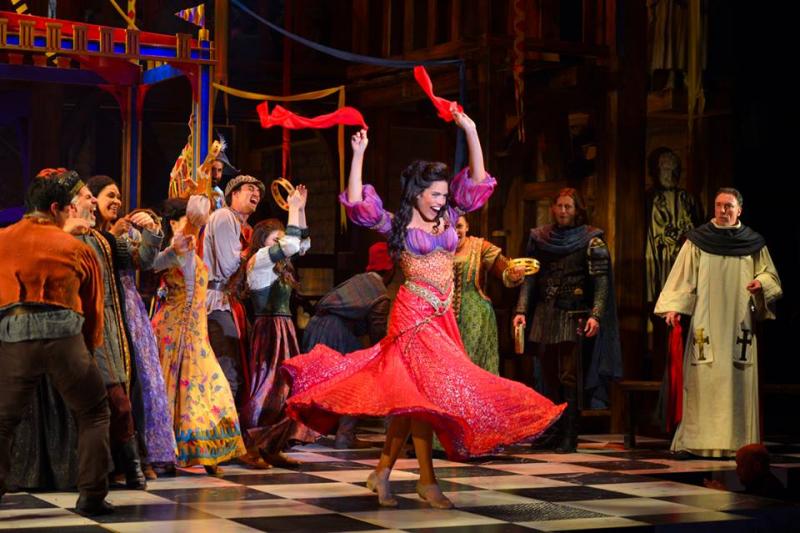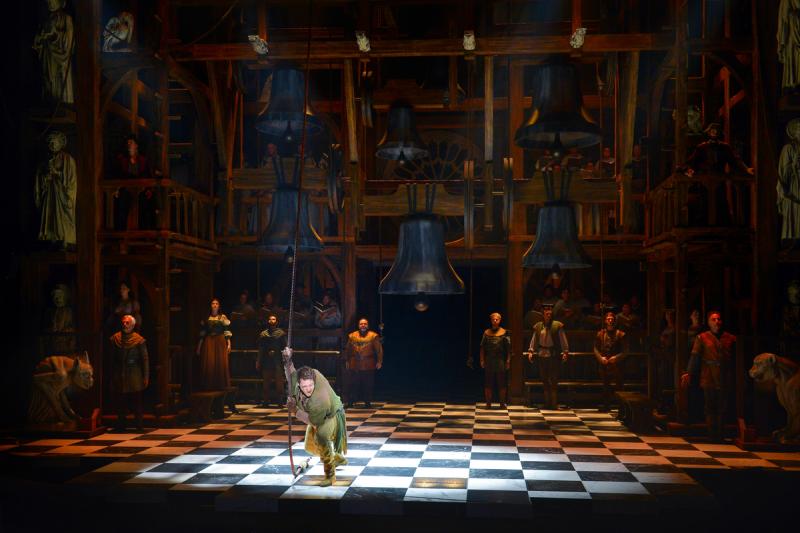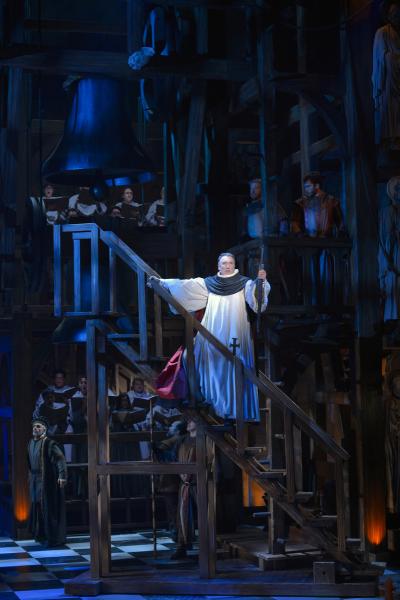La Jolla's 'The Hunchback Of Notre Dame' Is A Musical Theater Blessing

This is the central question posed by the Disney film, “The Hunchback of Notre Dame,” an animated reinvention of Victor Hugo’s 1831 novel “Notre-Dame de Paris.” The film answers this question clearly; the hideous, deformed Quasimodo (Michael Arden) and the gypsy dancer Esmeralda (Ciara Renée) are both paragons of purity and righteousness, while the most powerful figure of authority, Dom Claude Frollo (Patrick Page), is an evil manipulator who twists faith into a weapon for his own personal desires.
A less clear cut, more profoundly complex answer to this riddle can be found in the staged musical version of “The Hunchback of Notre Dame,” which is enjoying its U.S. premiere directed by Scott Schwartz at the La Jolla Playhouse.
Alan Menken and Stephen Schwartz’s revisitation of their original work on the Disney movie is an absolute triumph. A return to and expansion upon the original score with an overhaul of the story by book writer Peter Parnell retains most of the elements that made audiences fall in love with the Disney classic while redeeming much of the artistic license taken with the film, creating a more just and accurate interpretation of Hugo’s original novel.
The opening number, “The Bells of Notre Dame,” is a tremendous shock for anyone familiar with the movie, as much of the backstory for the musical is rewritten. This sets a precedent for the rest of the production; although much of the score is transplanted from the film, many lyrics and plot elements are changed in addition to a variety of brand new songs and scenes.
SEE ALSO: 'Into The Woods' Has A Spellbinding Reunion
In particular, Frollo’s backstory is totally reworked to bring the novel’s antagonist to life and create a much more complicated and nuanced character. The touching story of his love for his estranged brother Jehan (Lucas Coleman), feeds the fire for his hatred of the gypsies, a driving force in the plot. Frollo himself decides to raise Jehan’s deformed child rather than throwing it away, and for all intents and purposes, is a fairly generous and well-meaning man, aside from some undertones of religious piety. Until his obsession with Esmeralda culminates in “Hellfire,” one of the most memorable songs from the film score, Frollo is not necessarily portrayed as a villain. He is a troubled man who has been led astray by difficult circumstances. The musical also restores Frollo to his role as Archdeacon, which was changed to that of a secularized judge in order to avoid religious controversy in the Disney version.

One of the most incredible theatrical moments in the show comes at the very beginning, with the introduction of Quasimodo. The protagonist steps out, a normal man without any physical defects, and in the climax of the opening number, pulls out a stick of makeup to add deformities to his face. Members of the ensemble emerge, attach the hunch to his back, and clothe him, and by the end of the number there is a fully realized transformation of a prototypical man into the titular “monster” of the show. This is simply one example of Scott Schwartz’s many brilliant and elegantly economic directing choices in the production.
One of the biggest surprises in this adaptation is the choice to make Quasimodo deaf and impair his ability to speak, as is his reality in the novel. Years of ringing the bells of the tower have robbed Quasimodo of nearly all his hearing, although he can read lips and accomplish basic communication with others. Menken, Schwartz and Parnell sidestep this potential obstacle with a brilliant bout of expressionism, allowing Quasimodo to speak and sing uninhibited when he has solo numbers or when he is talking to his imaginary friends in the bell tower (a clever use of the ensemble to replace the three animated gargoyles in the film). This drives home a central message of the show—that underneath the disfigured exterior is a man like any other.
SEE ALSO: 'Cannibal! The Musical' Is Deliciously Fresh And Innovative
Stellar performances dominate the production, with no apparent weak links despite a sizable cast. Of particular note is Page’s Frollo, whose nuanced performance makes “The Hunchback of Notre Dame” Frollo’s tragedy just as much as it is Quasimodo’s. Vocal performances are also outstanding all around, and are complemented by an onstage chorus sung by San Diego’s SACRA/PROFANA to accentuate the gothic, spiritual setting.
The setting may be the most important element of the story. Victor Hugo wrote his novel in part to guilt the nineteenth century government of France into restoring Notre Dame to its former glory, and most of the plot revolves around locations inside or surrounding the cathedral.

Alexander Dodge’s intricate scenic design transports the audience to the cathedral using easily recognizable imagery (such as the central rose window and stone depictions of saints) and the crisscross beams that dominate the architecture of the building. Howell Binkley’s lighting design distinguishes the divine glow of the cathedral from exterior locations and reveals important, powerful thematic elements. The use of fire as a literal and metaphorical weapon is particularly poignant. Alejo Vietti’s costume design is refreshingly subtle; it is effective without turning the characters into the archetypes they are in the Disney movie.
Young audiences who grew up with the Disney movie may be shocked at the darkness of this new version. Despite being significantly darker than the typical Disney work, the film doesn’t even begin to scratch the surface of some of the more adult themes Hugo wrote about.
La Jolla’s production of "The Hunchback of Notre Dame" rights the wrongs done to Hugo’s intentions, to a surprising and courageous degree. The show is bold, unashamed, and truly touching. It is tragic, sweet, disturbing, inspiring, and revelatory. The exciting work that La Jolla Playhouse has done to bring this old and classic tale to the stage may finally bring “The Hunchback of Notre Dame” to the forefront of American theatre on the Broadway stage, and sets the gold standard for musical theatre adaptions to come.
Needless to say, Disney fans and devout theatre-goes have something to be very excited about in the future ahead.
"The Hunchback of Notre Dame" is playing through December 14 at La Jolla Playhouse's Mandell Weiss Theatre (2910 La Jolla Village Dr., La Jolla, CA). Tickets start at $15. For more information visit www.LaJollaPlayhouse.org
Reach Staff Writer Ryan David McRee here.
For more Theater & Dance coverage click here.



